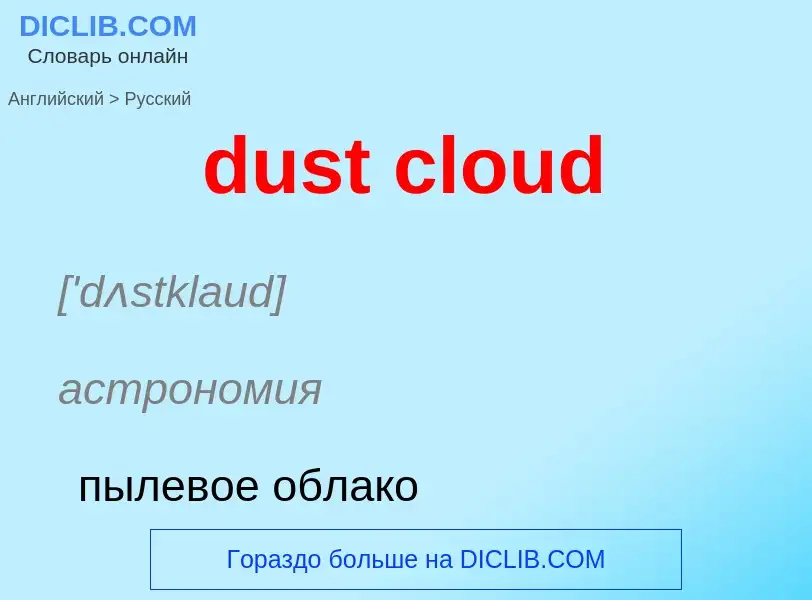Vertaling en analyse van woorden door kunstmatige intelligentie ChatGPT
Op deze pagina kunt u een gedetailleerde analyse krijgen van een woord of zin, geproduceerd met behulp van de beste kunstmatige intelligentietechnologie tot nu toe:
- hoe het woord wordt gebruikt
- gebruiksfrequentie
- het wordt vaker gebruikt in mondelinge of schriftelijke toespraken
- opties voor woordvertaling
- Gebruiksvoorbeelden (meerdere zinnen met vertaling)
- etymologie
dust cloud - vertaling naar russisch
['dʌstklaud]
астрономия
пылевое облако
облако космической пыли
общая лексика
космическая пыль
Definitie
Wikipedia
The interplanetary dust cloud, or zodiacal cloud (as the source of the zodiacal light), consists of cosmic dust (small particles floating in outer space) that pervades the space between planets within planetary systems, such as the Solar System. This system of particles has been studied for many years in order to understand its nature, origin, and relationship to larger bodies. There are several methods to obtain space dust measurement.
In the Solar System, the interplanetary dust particles have a role in scattering sunlight and in emitting thermal radiation, which is the most prominent feature of the night sky's radiation, with wavelengths ranging 5–50 μm. The particle sizes of grains characterizing the infrared emission near Earth's orbit typically range 10–100 μm. Microscopic impact craters on lunar rocks returned by the Apollo Program revealed the size distribution of cosmic dust particles bombarding the lunar surface. The ’’Grün’’ distribution of interplanetary dust at 1 AU, describes the flux of cosmic dust from nm to mm sizes at 1 AU.
The total mass of the interplanetary dust cloud is approximately the mass of an asteroid of radius 15 km (with density of about 2.5 g/cm3). Straddling the zodiac along the ecliptic, this dust cloud is visible as the zodiacal light in a moonless and naturally dark sky and is best seen sunward during astronomical twilight.
The Pioneer spacecraft observations in the 1970s linked the zodiacal light with the interplanetary dust cloud in the Solar System. Also, the VBSDC instrument on the New Horizons probe was designed to detect impacts of the dust from the zodiacal cloud in the Solar System.

![extrasolar interplanetary dust]] cloud extrasolar interplanetary dust]] cloud](https://commons.wikimedia.org/wiki/Special:FilePath/Artist’s impression of bright exozodiacal light image.jpg?width=200)
![access-date=14 February 2017}}</ref> ''[[gegenschein]]'' and the rest of its band, which is visually crossed by the [[Milky Way]]. access-date=14 February 2017}}</ref> ''[[gegenschein]]'' and the rest of its band, which is visually crossed by the [[Milky Way]].](https://commons.wikimedia.org/wiki/Special:FilePath/False Dawn.jpg?width=200)
![First ever panorama image of the dust ring of Venus's orbital space, imaged by [[Parker Solar Probe]]. First ever panorama image of the dust ring of Venus's orbital space, imaged by [[Parker Solar Probe]].](https://commons.wikimedia.org/wiki/Special:FilePath/Venus dust ring.png?width=200)
![brownout]]s) stirred up by [[downwash]] from [[military helicopter]]s. brownout]]s) stirred up by [[downwash]] from [[military helicopter]]s.](https://commons.wikimedia.org/wiki/Special:FilePath/121127-M-EF955-151 (8245266781).jpg?width=200)



![Cosmic dust of the [[Andromeda Galaxy]] as revealed in infrared light by the [[Spitzer Space Telescope]]. Cosmic dust of the [[Andromeda Galaxy]] as revealed in infrared light by the [[Spitzer Space Telescope]].](https://commons.wikimedia.org/wiki/Special:FilePath/Andromeda galaxy Ssc2005-20a1.jpg?width=200)


![Cosmic dust of the [[Horsehead Nebula]] as revealed by the [[Hubble Space Telescope]]. Cosmic dust of the [[Horsehead Nebula]] as revealed by the [[Hubble Space Telescope]].](https://commons.wikimedia.org/wiki/Special:FilePath/Horsehead-Hubble.jpg?width=200)



